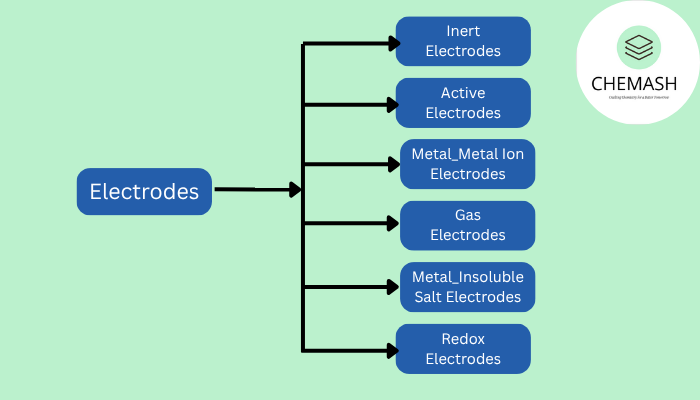Types of Electrodes in Electrochemistry
Understanding the components that enable redox reactions
What is an Electrode?
An electrode is a solid conductor (usually a metal or graphite) that facilitates the transfer of electrons to and from the electrolyte. In an electrochemical cell, oxidation occurs at the anode and reduction at the cathode.
Types of Electrodes

1. Inert Electrodes
These do not react with the electrolyte or the ions involved. Examples: Platinum, Graphite.
2. Active Electrodes
These participate in the redox reaction. Common examples: Zinc, Copper.
3. Metal-Metal Ion Electrodes
Consist of a metal in contact with its ion solution. Example: Zn/Zn²⁺.
4. Gas Electrodes
Include a gas, usually with a platinum conductor. Example: Hydrogen electrode.
5. Metal-Insoluble Salt Electrodes
Made from a metal and its slightly soluble salt. Example: Ag/AgCl.
6. Redox Electrodes
Used when both oxidized and reduced species are in solution. Inert electrode (like Pt) is used.
Summary Table
| Type | Material | Function / Use |
|---|---|---|
| Inert | Pt, Graphite | Conduction only, no reaction |
| Active | Zn, Cu, Ag | Participates in redox reaction |
| Metal-Ion | Metal rod + ion solution | Standard redox half-cells |
| Gas | H₂, O₂ with Pt | Redox involving gases |
| Metal-Salt | Ag/AgCl | Reference electrode |
| Redox | Pt with ions in soln | Transfers electrons for redox pair |
Electrodes are the foundation of every electrochemical reaction — from batteries to biosensors.
Quick Quiz: True or False?
- ✅ Platinum is an example of an inert electrode. — True
- ❌ All electrodes participate in redox reactions. — False
- ✅ Ag/AgCl is used as a reference electrode. — True
Related Posts:
- Difference Between Galvanic and Electrolytic Cells
- Types of Electrochemical Cells
- Standard Hydrogen Electrode – Working & Construction
Quiz: Types of Electrodes
- Which of the following is an example of an inert electrode?
A. Zinc
B. Copper
C. Platinum
D. Silver
Correct Answer: C. Platinum
Explanation: Platinum does not participate in redox reactions and only conducts electrons, making it an inert electrode. - What type of electrode is used in the Standard Hydrogen Electrode (SHE)?
A. Active
B. Gas
C. Metal-salt
D. Redox
Correct Answer: B. Gas
Explanation: SHE involves hydrogen gas in contact with a platinum electrode – a classic example of a gas electrode. - Which electrode consists of a metal and its slightly soluble salt?
A. Gas electrode
B. Redox electrode
C. Metal-metal ion
D. Metal-insoluble salt
Correct Answer: D. Metal-insoluble salt
Explanation: Example: Ag/AgCl is a metal-insoluble salt electrode, used as a reference. - Which of the following electrodes participates in the redox reaction?
A. Platinum
B. Graphite
C. Zinc
D. All of the above
Correct Answer: C. Zinc
Explanation: Zinc is an active electrode, meaning it undergoes oxidation or reduction. - In a redox electrode, which material is typically used?
A. Ag/AgCl
B. Copper
C. Platinum
D. Zinc
Correct Answer: C. Platinum
Explanation: Redox electrodes use inert platinum electrodes to facilitate electron transfer without participating in the reaction.
